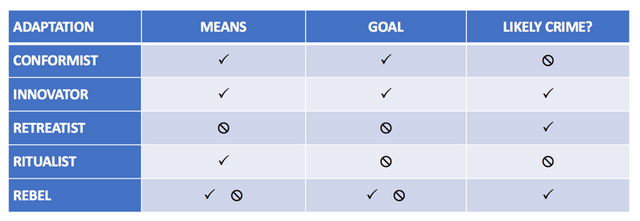Why Do People Commit Crimes? Examining Merton's Strain Theory
One cold evening, Jane was walking down a long, lonely road which ran into her home. She had had a frantically busy day in school, boring lectures that lasted longer than scheduled. And when the whole academic madness was over, she had to return home quite late.
By now thousands of stars were already peeping from the sprawling curtains of the sky, although the Moon was yet to retun from its sabbatical. Jane knew the dangers that could come with the looming darkness. So, she walked faster than usual, hoping the darkness would not overtake her.
Unfortunately, just when Jane got to the sharp bend before her home, a hefty-looking young man, who had been lurking behind a mango tree, bounced on her from behind. She crashingly fell to the ground. Immediately, the strange man bent over her, covered her mouth with one hand while he pointed a pistol to her head with the other.
"I'll blow off your head if you do not cooperate" the unknown young man threatened."But I'll not hurt you if you do not prove stubborn."
Jane submitted herself, knowing it was unwise to struggle with hoodlums. At last, the criminal carted away Jane's laptop and the wad of dollar notes in her wallet. Jane got home that evening, traumatized.
Crime, the Headache of Modern Societies
The story of Jane is familiar in all known modern societies today. Every day thousands of people become victims of both petty and organized crimes globally. In short, crime has become a monster, one that seems too unruly for the police and other sister institutions to tame.
In the United States, for instance, a report published by the FBI indicated that there were 1.2 million cases of violent crimes in 2016. In that same year, 7.9 million cases of property crimes were reported causing staggering loses estimated at $15.6 billion. This tells us that the criminal industry is a notoriously profitable one.
Why Do People Commit Crimes?
For decades, scholars in the filed of Sociology and Psychology have attempted to explain why people commit crimes. And quite interestingly, several theories have been developed over the years to explain criminality. An Italian psychiatrist and physician, Cesare Lombroso, even went as far as postulating that criminals are born and not made. Physical attributes, Lombroso observed, determine whether a person will develop criminal tendencies or not.
Today, I will be examining one of the most fascinating theories of criminal behaviour - the strain theory of crime developed by Robert K. Merton. In a lucid language, this essay will discuss the basic assumptions of Merton's Strain Theory, its strength and its weaknesses.
Merton's Strain Theory
In 1938 and 1968, Robert K. Merton, a prominent American Sociologist, developed the strain theory through a series of papers. Merton began his theory by refuting the earlier work of Lombroso who, as already mentioned above, associated Biology with criminality. Merton stated that Biology has no valid explanations for crimes. For Merton, crime is a social problem that can only be explained by an examination of the social structure.
Therefore, Merton argued that people commit crimes because of the pressure (strain) which the society put on them. This, Merton observed, explains why crime rate varies across different societies. In an attempt to make his theory compelling, Merton elaborated the concept of anomie(which was originally developed by Emile Durkheim, a founding father of Sociology). Anomie simply refers to a state of lawlessness and disorderliness resulting from the breakdown of social norms. Merton postulated that anomie occurs in the society when individuals are unable to legitimately achieve societal goals through socially approved means.
Writing in the American society, Merton observed that the American society, like every modern society, has socially approved goals such as success, wealth, fame, etc and socially approved means such as education and hard work. However, the socially approved means are not equally available to every individual in the society. So, in order to achieve societal goals, underprivileged individuals resort to crimes while privileged individuals (those who have access to the approved societal means) conform. By implication, Merton tells us that the individual who commits crime, in fact, has the same goals and aspirations as the brilliant student studying in Harvard.
Merton identified five ways through which individuals adapt to the strain put on them by the society. They adaptations are namely: Conformity, Innovation, Ritualism, Retreatism, and Rebellion. I will briskly explain these adaptations below:

Image Credit
Conformity: As described in the diagram above, the conformist are those who accept both the socially approved goals and means. These are largely the law abiding citizens.
Innovation: The innovator accepts the socially approved goals but reject the means. They therefore devise illegal means to achieve the socially approved goals. Drug dealers, fraudsters, etc fit quite perfectly into this adaptation.
Ritualism: The ritualists are those who reject the socially approved goals but accept the means to achieve the goals. They are usually religious people.
Retreatism: The retreatist rejects both the socially approved goals and the means. They neither believe in becoming successful nor acquiring education. The retreatist is usually a drug addict.
Rebellion: The rebel rejects both the socially approved goals and the means. He goes further to replace them with different goals and means. The rebel wants to create a new social order. A good example are terrorists organizations such as Al Qaeda and ISIS.
Criticisms
Like most theories in the Social Sciences, Merton's Strain theory has been criticized. For the purpose of this essay, I will only point out two of the most relevant criticisms.
First, Merton's Strain theory has been criticized for its inability to explain white collar crimes such as forgery, money laundering, corruption, etc. The perpetrators of these crimes are usually highly educated people who have access to the socially approved means of achieving societal goals.
Second, the adaptations in Merton's theory are not categorical. In reality, a conformist may alternate between being a conformist and an innovator and vice versa.
Conclusion
Despite its many weaknesses, Merton's strain theory has been insightful in the understanding of criminality. Merton was one of the earliest scholars whose work turned attention from blaming individuals for committing crimes to blaming the society for latently developing strain that forces individuals into criminality.
REFERENCES
Macionis, J.J (1987), Sociology, 3rd Edition. P.g 206.
Wikipedia: Strain Theory
FBI Crime Statistics 2016
Robert K. Merton's Strain Theory Explained
The Theories of Cesare Lombroso: Born Criminal

@resteemator is a new bot casting votes for its followers. Follow @resteemator and vote this comment to increase your chance to be voted in the future!
As a follower of @followforupvotes this post has been randomly selected and upvoted! Enjoy your upvote and have a great day!
They say risk only comes from not knowing what you are doing.